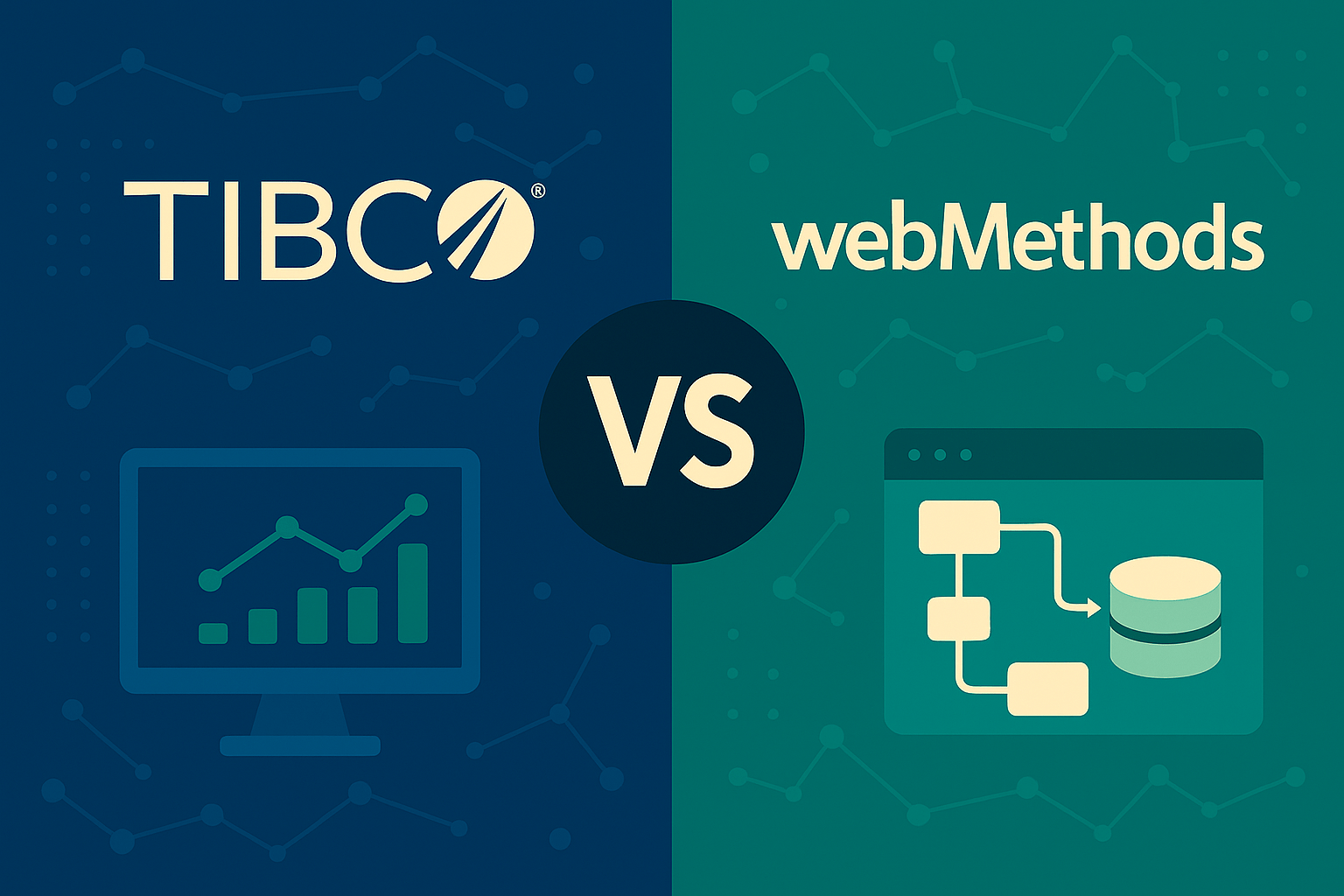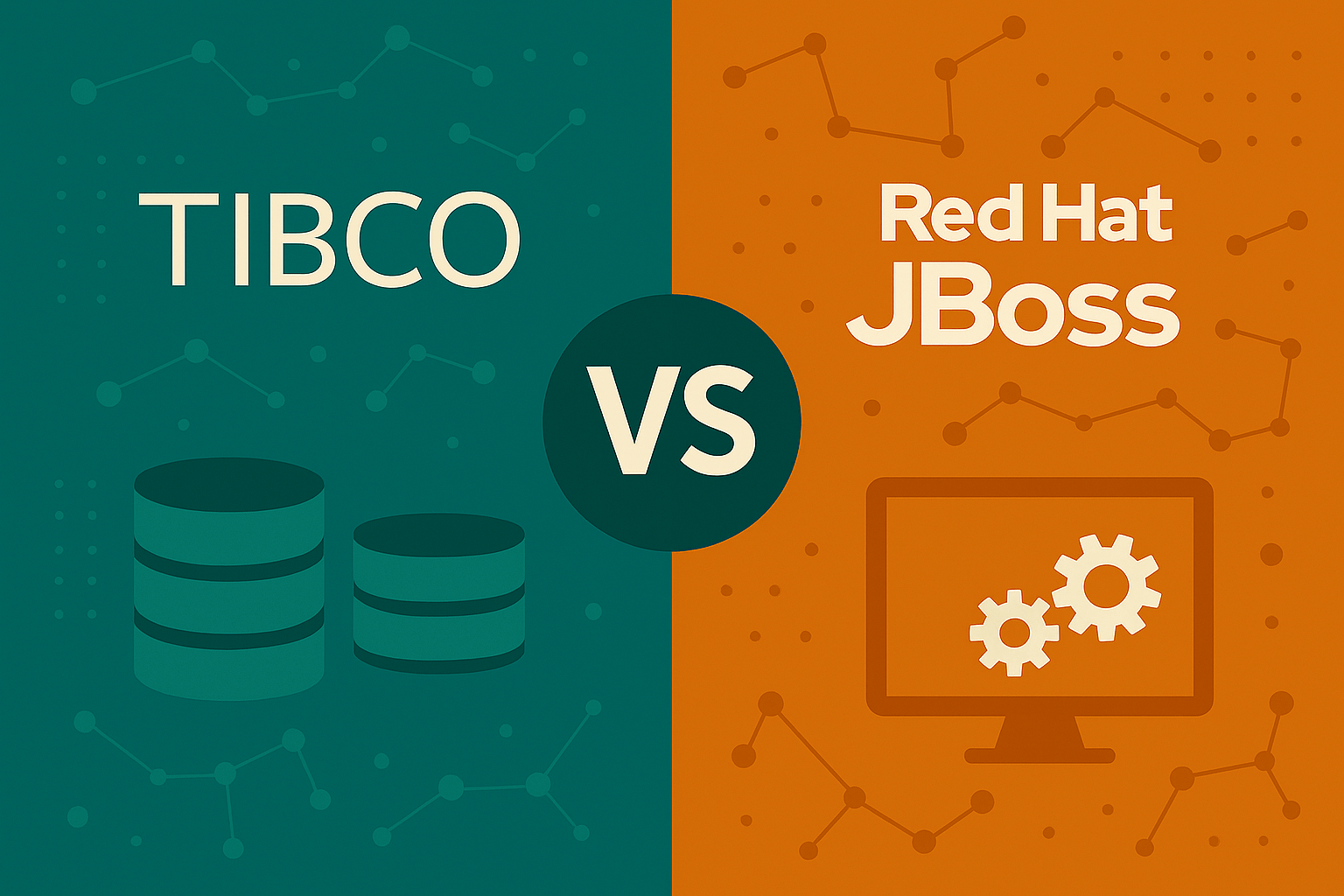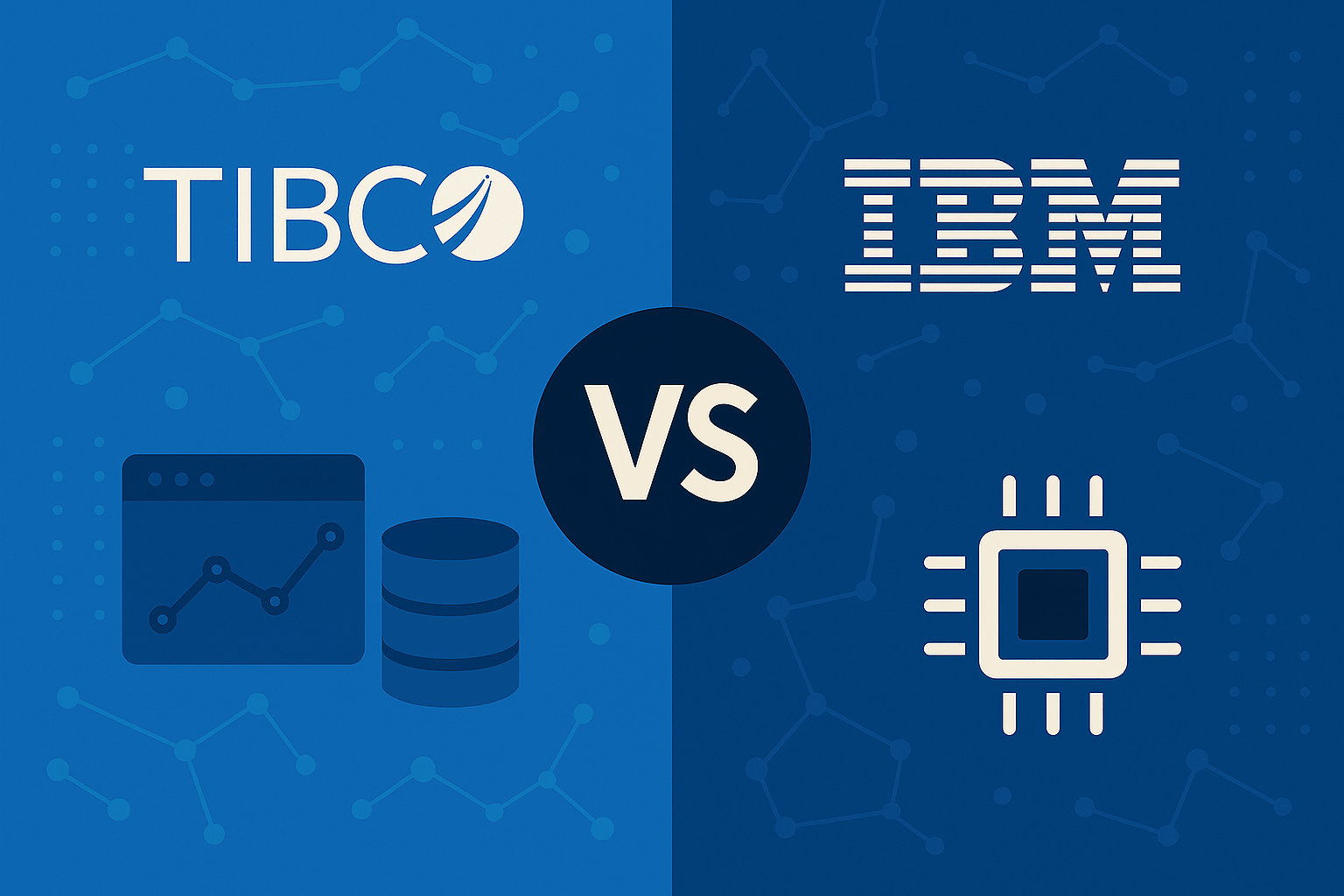TIBCO vs Pega: Which BPM Platform is Right for Your Business?
Choosing between TIBCO and Pega for your business process management needs can determine your digital transformation success. Both platforms dominate the enterprise BPM market, but they excel in distinctly different areas that serve specific business requirements.
The decision between these two leading business process automation solutions impacts everything from development speed to integration capabilities. TIBCO software specializes in real-time data processing and complex system integration, supported by a strong integration framework that accommodates various protocols and data formats. Meanwhile, Pega platform excels in case management and low code development environments. Additionally, Pega BPM offers a robust suite of integration tools for seamless connectivity with various enterprise systems.
Understanding which tool fits your organization’s needs requires examining their core strengths, implementation requirements, and how they align with your business processes. This comprehensive comparison will guide you through the key factors that matter most for your business process management investment.
Choose the Right BPM Platform for Your Success
The tibco vs pega debate centers on two fundamentally different approaches to business process automation. TIBCO excels in integration-heavy environments where real-time data processing drives complex workflows across multiple systems. Pega dominates scenarios requiring sophisticated case management and rapid deployment through its low code platform.
Both solutions represent enterprise-grade BPM tools, but their architectural differences create distinct advantages. Organizations with extensive legacy systems and complex data integration needs often find TIBCO’s connectivity framework more suitable. Businesses prioritizing rapid application development and business user empowerment typically favor Pega’s visual development approach. Both platforms also offer flexible deployment options, including on-premises, cloud, and hybrid environments, catering to diverse infrastructure requirements.
The decision factors extend beyond technical capabilities to include integration complexity, case management requirements, and preferred development methodologies. Your specific needs around automation, workflow complexity, and user interface requirements will heavily influence which platform delivers better ROI.
Market positioning shows Pega holds 5.6% BPM mindshare according to recent industry analysis, representing a slight decline from previous years. While TIBCO’s market share appears smaller in pure BPM categories, its strong integration heritage creates significant adoption in hybrid process automation scenarios.
What Makes These BPM Platforms Unique?
TIBCO BPM - Integration-First Architecture
TIBCO software built its reputation on powerful integration capabilities that connect diverse applications and data sources across enterprise environments. The platform excels in event-driven architecture where real-time data processing triggers automated business processes across multiple systems simultaneously. TIBCO iProcess Suite is noted for its process automation capabilities, which strengthen its automation command.
The integration framework enables organizations to streamline complex workflows that span legacy systems, cloud services, and modern applications. TIBCO BusinessWorks serves as the backbone for these connections, providing robust messaging and data transformation capabilities that other tools struggle to match.
Strong analytics and reporting capabilities deliver immediate insights into business processes through real-time monitoring and dashboards. The platform’s ability to handle high-throughput scenarios makes it particularly valuable for organizations demanding sub-second response times and robust failover support.
ActiveMatrix BPM (AMX BPM) suits long-term, complex business processes involving multiple users with different privilege levels. The platform provides excellent visibility during design and development phases, supported by technical teams that remain always available throughout implementation.
TIBCO’s event processing capabilities through BusinessEvents enable organizations to respond instantly to streaming data or system events. This makes the platform especially effective for fraud detection, service interruption management, and logistics optimization where real time processing determines business outcomes.
Pega BPM - Case Management Excellence
Pega platform revolutionizes business process automation through its low code development environment via App Studio, enabling business analysts to build sophisticated applications without extensive coding knowledge. This approach accelerates time-to-market while reducing dependency on technical developers for routine modifications.
The platform’s case management capabilities unify disparate tasks, documents, and interactions around single business objectives. This unified approach proves particularly valuable in industries like healthcare, insurance, and financial services where complex customer journeys require coordinated automation across multiple touchpoints.
User-friendly interface design combined with extensive documentation and community support makes Pega accessible to broader organizational teams. Business users can modify workflows, update business rules, and adapt processes to changing requirements without waiting for IT resources.
AI-driven decision-making capabilities distinguish Pega from traditional BPM solutions by enabling hyper-personalized processes and real-time recommendations. These advanced features prove especially valuable in customer engagement scenarios, compliance processes, and dynamic pricing applications.
Rapid application development accelerates deployment through built-in connectors and wide API support. The platform’s model-driven architecture allows organizations to define business logic, processes, and user interfaces visually, reducing development complexity while maintaining sophisticated functionality.
TIBCO vs Pega: Platform Comparison
Development Approach
TIBCO follows traditional development methodologies requiring technical expertise and coding knowledge from implementation teams. Developers need familiarity with Java, integration patterns, and complex system architectures to fully leverage the platform’s capabilities. This approach provides maximum flexibility for custom development but creates a steeper learning curve for business teams.
Pega platform prioritizes low code development allowing business users to build and modify applications through visual interfaces. App Studio enables business analysts to create sophisticated workflows without deep programming knowledge, though understanding object-oriented programming fundamentals helps developers maximize the platform’s potential.
The development approach differences impact project timelines and resource requirements significantly. TIBCO implementations typically require longer development cycles but offer greater customization for complex integration scenarios. Pega enables faster time-to-market through its visual development tools, though highly customized requirements may still demand technical expertise.
Both platforms support agile development methodologies, but Pega’s citizen development capabilities align better with rapid iteration and business-driven modifications. TIBCO’s strength lies in scenarios where technical precision and performance optimization outweigh development speed considerations.
Core Strengths
TIBCO’s integration capabilities, real-time processing, and advanced analytics create powerful automation for organizations managing complex IT environments. The platform excels in scenarios requiring high-performance data integration, event-driven responses, and sophisticated system connectivity across diverse technology stacks.
Pega platform dominates case management, business rules engine functionality, and customer engagement scenarios through its unified approach to process automation. The platform’s strength in handling dynamic, human-centric workflows makes it particularly valuable for customer service automation and compliance processes.
Event-driven architecture represents TIBCO’s core differentiator, enabling organizations to build responsive systems that adapt instantly to changing conditions. This capability proves essential for supply chain optimization, IoT event handling, and financial trading operations where millisecond responses impact business outcomes.
Pega’s unified platform approach integrates process automation, case management, and customer engagement into cohesive solutions. Strong decisioning capabilities powered by AI enhance the platform’s ability to deliver personalized experiences and automated recommendations throughout customer journeys.
Deployment and Scalability
Both platforms support on-premises, cloud services, and hybrid deployment options, providing flexibility for organizations with diverse infrastructure requirements. This deployment flexibility enables companies to align BPM implementation with existing security policies and compliance requirements. Additionally, third-party services like ApiX-Drive can be utilized to automate workflows and integrate various applications with both Pega BPM and TIBCO BPM, simplifying implementation processes.
TIBCO demonstrates particular strength for enterprises requiring high-performance integration across complex system landscapes. The platform’s architecture handles high-throughput scenarios effectively, making it suitable for mission-critical workloads demanding consistent performance under load.
Pega offers smoother deployment processes with quicker ROI realization despite higher initial setup costs. The platform’s model-driven architecture and pre-built templates accelerate implementation timelines, though complex customizations may extend deployment schedules.
Both solutions scale effectively for large enterprise applications, but their scaling characteristics differ. TIBCO scales particularly well for integration-intensive scenarios, while Pega scales effectively for user-centric applications and case management workflows across large organizations.
What Industry Professionals Say
TIBCO users consistently praise the platform’s integration capabilities and real-time data processing strengths for managing complex IT environments. Organizations implementing TIBCO report particular satisfaction with the platform’s ability to connect legacy systems with modern applications while maintaining high performance standards.
Pega users highlight the user-friendly interface, case management strength, and rapid development capabilities as key advantages. Business teams appreciate the platform’s ability to empower non-technical users while still providing sophisticated automation capabilities for complex business processes. Its robust case management capabilities and ease of use also make it an excellent choice for freshers entering the BPM field. Career opportunities in TIBCO and Pega are promising for freshers and those considering a career switch.
Industry adoption patterns reveal interesting insights about platform preferences. Financial services organizations represent 31% of adoption, while insurance companies account for 17% of implementations. Enterprise segments dominate usage at 86-95%, indicating both platforms serve primarily large organization needs. Pega and TIBCO skills are in high demand, and professionals in these areas can expect good salary prospects.
Over 862,000 professionals have utilized comparison research since 2012 to evaluate these platforms against alternatives. This extensive evaluation history demonstrates the platforms’ maturity and the thorough consideration organizations apply when selecting business process management solutions.
TIBCO frequently wins evaluations against IBM and Oracle competitors due to superior cost structures and architectural fit for integration-heavy requirements. Organizations particularly value TIBCO’s ability to handle real-time event processing while maintaining competitive pricing compared to larger enterprise software vendors.
User satisfaction metrics from TrustRadius show both platforms scoring 9.7 out of 10 for small and medium-sized businesses, dropping to 9.3 for large enterprises. This pattern suggests both platforms excel in mid-market scenarios while facing increased complexity challenges in the largest organizational implementations.
Implementation Requirements Overview
TIBCO implementations require technical expertise including Java knowledge and deep understanding of integration patterns. Development teams need familiarity with web services, integration protocols, deployment architectures, and database connectivity to maximize platform effectiveness.
Pega requires understanding of object-oriented programming fundamentals for developers, but business users can effectively work within App Studio without extensive technical backgrounds. This dual-level approach enables broader organizational participation while maintaining technical depth where needed.
Both platforms demand proper training and certification programs for optimal results. TIBCO training focuses on web services integration, deployment methodologies, and database connectivity. Pega emphasizes case management concepts, business rules configuration, and customer journey mapping. Learning the basic principles of web services and integration can help freshers adapt quickly to TIBCO and Pega.
Technical skill requirements create different staffing implications for organizations. TIBCO implementations typically require dedicated technical teams with integration expertise, while Pega enables broader participation from business analysts and process experts alongside technical developers.
Third-party integration tools like ApiX-Drive can enhance both platforms’ connectivity capabilities, particularly for organizations needing simplified integration with cloud services and SaaS applications. These tools can reduce implementation complexity while extending platform capabilities.
Learning curve considerations vary significantly between platforms. TIBCO demands higher initial technical investment but provides powerful capabilities for organizations with appropriate expertise. Pega offers more accessible entry points while still requiring investment in platform-specific knowledge for advanced features.
Which BPM Platform is Right for You?
Choose TIBCO BPM if you need:
Strong integration capabilities across diverse systems and data sources represent TIBCO’s primary value proposition. Organizations managing complex IT landscapes with multiple legacy systems, cloud services, and real-time data requirements find TIBCO’s connectivity framework essential for effective automation.
Real-time data processing and event-driven architecture suit businesses where immediate response to changing conditions drives competitive advantage. Supply chain optimization, financial trading, IoT monitoring, and fraud detection scenarios particularly benefit from TIBCO’s real-time processing capabilities.
Advanced analytics and reporting for complex business processes provide the immediate insights necessary for operational optimization. Organizations requiring sophisticated monitoring, performance analysis, and predictive capabilities across integrated systems find TIBCO’s analytics framework valuable.
Cost-effective solutions with powerful technical capabilities appeal to organizations prioritizing functionality over ease-of-use. TIBCO often provides better value for technically sophisticated teams managing integration-heavy automation requirements.
Long-term, complex processes involving multiple user types and privileges align well with TIBCO’s architecture. Organizations managing workflows spanning departments, systems, and external partners benefit from TIBCO’s robust process orchestration capabilities.
Choose Pega BPM if you want:
Comprehensive case management and customer engagement capabilities distinguish Pega in scenarios requiring unified customer experiences. Organizations prioritizing customer journey optimization, service automation, and engagement across multiple channels find Pega’s case management approach especially valuable.
Low code development enabling business users to build applications accelerates organizational agility and reduces IT bottlenecks. Companies wanting to empower business teams while maintaining sophisticated automation capabilities benefit from Pega’s citizen development approach.
Rapid application development with AI-driven decision-making provides competitive advantages in dynamic markets. Organizations needing to adapt quickly to regulatory changes, market conditions, or customer expectations find Pega’s rapid deployment capabilities essential.
Strong business rules engine and unified platform approach simplify complex process management across organizational functions. Companies seeking to consolidate multiple automation tools into cohesive solutions often find Pega’s integrated platform approach advantageous.
End-to-end automation with excellent user experience design suits organizations prioritizing employee and customer satisfaction alongside operational efficiency. Pega’s focus on intuitive interfaces and user experience proves valuable for companies emphasizing adoption and engagement.
The choice between TIBCO and Pega ultimately depends on your organization’s specific integration complexity, case management requirements, and development approach preferences. Organizations with heavy integration needs and technical teams often find TIBCO’s capabilities worth the additional complexity. Companies prioritizing business user empowerment and rapid deployment typically achieve better outcomes with Pega’s low code platform.
Consider conducting proof-of-concept implementations with both platforms to evaluate how each aligns with your specific business needs, technical capabilities, and organizational culture. This hands-on evaluation approach often reveals practical differences that influence long-term success more than theoretical comparisons.
Factory Thread – Lightweight, Real-Time Process Orchestration for Industrial Operations
While TIBCO emphasizes integration complexity and Pega leads in case management for service-heavy industries, Factory Thread brings a third, purpose-built approach to BPM—real-time workflow automation for manufacturing and industrial enterprises.
Factory Thread combines low-code process design, edge deployment, and streaming data orchestration into a unified platform tailored for factories, plants, and operational technology teams. Unlike TIBCO’s heavyweight infrastructure or Pega’s customer-centric focus, Factory Thread delivers trigger-based automation, alerting, and system bridging with minimal configuration.
Key differentiators:
-
Designed for OT and shop floor teams – No extensive IT resources required
-
Built-in data transformation and logic engine – No-code rules, formulas, and conditions
-
Native integration with ERP, MES, SCADA, and IoT – Fast connectivity without middleware
-
Live process visibility – Monitor and adjust flows in real time
Factory Thread is ideal for organizations that need fast, lightweight BPM without sacrificing power or visibility. It’s a modern solution for those stuck between over-engineered enterprise platforms and brittle custom code.
Share this
You May Also Like
These Related Stories

TIBCO vs webMethods: Choosing the Right Integration Solution for You

TIBCO vs JBoss: Which Enterprise Platform is Right for Your Business?



No Comments Yet
Let us know what you think